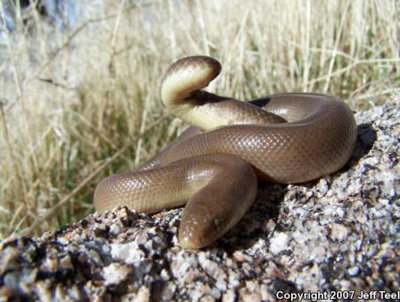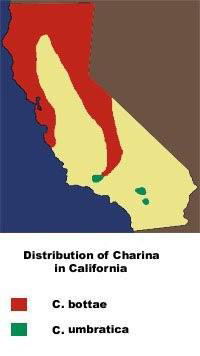Charina bottae umbratica
- Under Review – Endangered Species Act
- Threatened – California Endangered Species Act (1971)
- Sensitive – U.S. Forest Service
- G2 Imperiled – NatureServe
A unique snake found in isolated locations in the Los Padres National Forest, the southern rubber boa literally looks and feels like rubber with its smooth, small scales and wrinkled skin. It also has the unique feature of having a tail that’s just about the same size as its head, which it uses to fool its predators. When threatened the snake coils its body, hides its head within its coils, and elevates its tail to trick an attacker into attacking the tail – so they often have scarred tails!
The populations of rubber boas found in the Los Padres are genetically unique in that biologists describe them as an “intergrade” between the northern rubber boa (which ranges from British Columbia and the northern Rockies to the southern Sierra and central coast) and a southern subspecies restricted to higher elevations in the San Bernardino and San Jacinto mountains. These intergrades look like the southern rubber boa but their genetics more closely resemble the northern rubber boa.
Habitat
The southern rubber boa is only found in California (the green areas marked on the map). On the Los Padres, the intergrade rubber boa is associated with forested areas from 6,500 to 8,000 feet in elevation, including Frazier, Tecuya, and Antimony peaks, Mount Pinos west to Cerro Noroeste, and Alamo Mountain. It can be found in forests consisting of Jeffrey pine, black oak, white fir, and other trees, and most often with very deep soils. Its preferred habitat is damp woodland and forest, large grassy meadows, and moist sandy areas along rocky streams. The snake makes extensive use of rodent burrows, and uses rock outcrops, downed logs, and a thick pine needle and duff layer for cover.
Unique Characteristics and Behavior
The rubber boa can vary in color from olive-green to reddish, tan, or chocolate brown and the southern rubber boa is the smaller of the subspecies, growing to no more than about 15 inches in length. It has a “prehensile” tail adapted to grasp or hold objects, allowing it to easily climb shrubs and small trees. It is also an excellent swimmer. The boa preys on small mammals, birds, and lizards, constricting them before swallowing them whole; however, the snake is very docile and is considered harmless to humans. It will actually curl up into a ball when picked up by hand!
The southern rubber boa hibernates through the winter, and females emerge from hibernation sometime around April. Mating occurs as soon as the snakes emerge from hibernation and continues through mid-May. By late August through September, female boas give birth to 2-8 live young about seven inches in length in loose soils, often under rocks or other objects, or inside decaying logs. The snakes are mainly active in the evening or sometimes on warm, moist, overcast days. Because of its secrecy and the fact that it lives below ground most of the time, the southern rubber boa is seldom seen.
Threats
The southern rubber boa is considered common in its range, but since its range is extremely limited and is being threatened by development and habitat degradation, it was listed as a threatened species by the State of California in 1971. The greatest threats to the southern rubber boa include habitat loss from resort development, off-road vehicle use, and logging/wood collecting.
Furthermore, habitat loss for the southern rubber boa can be caused by the removal of downed logs, particularly following a wildfire. This threat is of particular concern in the area burned by the Day Fire in 2006, as the Forest Service at one point proposed piling and burning downed trees and authorizing commercial logging in boa habitat. The removal of vegetation for fuel breaks and forest thinning projects may also adversely affect southern rubber boas and their habitat by removing cover and drying out the soil.
The Center for Biological Diversity petitioned the U.S. Fish and Wildlife Service to list the species as endangered or threatened under the Endangered Species Act in 2012. The agency announced that listing may be warranted for the species based on the petition in 2015, and they requested more information from the public.
ForestWatch is continuing to monitor projects that might impact the southern rubber boa to ensure that these unique critters are protected.
More Information
- Read the southern rubber boa’s species account.








